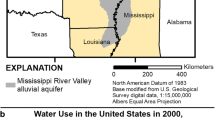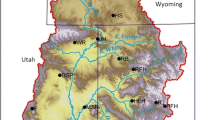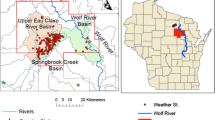Abstract
Groundwater abstraction has resulted in spring flow and groundwater base-flow declines in the Hillsborough River system of central Florida, USA. These declines have resulted in reduction of inflows to the Tampa city reservoir as well as likely adverse environmental effects on riverine and estuarine biota. Causes evaluated for the declines include effects of groundwater development, reduced rainfall, and land alterations. The karstic, heterogeneic nature of the area renders groundwater flow modeling an ineffective method for overall evaluation. Therefore, the evaluation of these declines is accomplished through the systematic use of parametric and nonparametric statistical techniques. These techniques include contingency table analysis, linear regression, Kendall-Theil and Mann-Kendall trend analysis, locally weighted regression, Pearson correlation, Kendall-tau correlation, Spearman correlation, runs test, Student’s t test, and the Kruskall-Wallis test. Data evaluated include groundwater withdrawals, rainfall, base flow, streamflow, stream stage, spring flow, and groundwater levels. Additional methods used include double mass analysis, base flow separation, a low-stage trend analysis, data visualization techniques, and water level change maps. The methodical application of these analyses and techniques to the hydrologic and climatic data yields the conclusion that the primary factor causing the spring flow and base-flow declines is lowered groundwater levels caused by over-abstraction.
Résumé
L’exploitation des eaux souterraines a induit la baisse du régime des sources et du débit d’étiage lié aux nappes, dans le système de la rivière de la Hillsborough, au centre de la Floride. Ces baisses ont eu pour résultats la réduction de l’afflux vers le réservoir de la ville de Tampa, ainsi que des effets environnementaux sur les biota des rives et de l’estuaire. Les causes de ces baisses - pompages, diminution des pluies, dégradation du sol – ont été estimées. La nature karstique et hétérogène de la zone rend la modélisation inapte à une évaluation globale. Dés lors, ces baisses sont évaluées grâce à l’application systématique de techniques statistiques paramétriques et non paramétriques. Ces techniques incluent des analyses par table de contingence, régression linéaire, tendances de Kendall-Theill et Mann-Khendall, Régression Polynômiale locale, corrélation de Pearson, corrélation de Kendall-tau, corrélation de Spearman, Runs test, test de Student, et test de Kruskall-Wallis. Les données évaluées sont les rabattements, les pluies, les débits d’étiage, autres débits, débits des sources et le niveau des nappes. D’autres méthodes utilisées incluent l’analyse par double masse, le découpage des hydrographes d’étiage, l’analyse des niveaux de base, différentes techniques de visualisation des données et enfin différentes cartes de niveau des eaux. L’application méthodologique de ces analyses et de ces techniques aux données climatiques et hydrologiques, conduit à la conclusion que le facteur primaire causant les baisses des débits et des niveaux, est la baisse des niveaux des nappes induit pas la sur-exploitation.
Resumen
La extacción de agua subterránea ha ocasionado descensos en el flujo de base de agua subterránea y en el flujo de manantial en el sistema del Río Hillsborough en el centro de Florida. Estos descensos han ocasionado la reducción de la entrada de flujos en el reservorio de la ciudad de Tampa así como también efectos ambientales negativos en la biota de los estuarios y ríos. Las causas que se han evaluado para explicar los descensos incluye el desarrollo de aguas subterráneas, reducción en la cantidad de lluvia, y alteraciones en el terreno. La naturaleza kárstica y heterogénea del área hace que el modelizado de flujo de agua subterránea sea un método poco efectivo para la evaluación. Por lo tanto, la evaluación de los descensos se ha llevado a cabo mediante el uso sistemático de técnicas estadísticas paramétricas y no paramétricas. Estas técnicas incluye el análisis de tabla de contingencia, regresión lineal, análisis de tendencias Mann-Kendall y Theil-Kendall, regresión pesada localmente, correlación Pearson, correlación tau-Kendall, correlación Spearman, pruebas de corrida, prueba t-Student, y la prueba Kruskall-Wallis. Los datos evaluados incluye extracciones de agua subterránea, flujo de base, escorrentía, niveles de río, flujo de manantial, y niveles de agua subterránea. Los métodos adicionales utilizados incluye el análisis de doble masa, la separación de flujo base, análisis de tendencia de etapa baja, técnicas de visualización de datos, y mapas de cambio de niveles de agua. La aplicación metódica de estos analisis y técnicas a los datos climáticos e hidrológicos conduce a la conclusión de que el principal factor causante de la disminución del flujo base y del flujo del manantial es el descenso de niveles de agua subterránea ocasionados por sobreexplotación.













Similar content being viewed by others
References
Bales JD, Pope BF (2001) Identification of changes in streamflow characteristics. J Am Water Res Assoc 37(1):91–104
Bredehoeft JD, Papadopulus SS,Cooper HH Jr (1982) Groundwater: the water budget myth in scientific basis of water resource management. National Research Council Geophysics Study Committee, National Academy Press, Washington, DC, pp 51–57
Cohen R (1992) Agricultural water use model, AGMOD, Version 2.0. Southwest Florida Water Management District, Brooksville, FL, p 25
Davis SN, DeWiest RJM (1966) Hydrogeology. Wiley, New York, p 463
Champion KM, DeWitt DJ (2000) Origin of nitrate in ground water discharging from Crystal Springs, Pasco County, Florida. Southwest Florida Water Management District, Brooksville, FL, p 192
Draper NR, Smith H (1981) Applied regression analysis, 2nd edn. Wiley, New York, p 709
Duerr AD (2001) Potentiometric surface of the upper Floridan Aquifer, west-central Florida, May 2001. US Geol Surv Open File Report, OF 01-0310, USGS, Reston, VA, p1
Florida Board of Conservation (1966) Florida land and water resources, Southwest Florida. Florida Board of Conservation, Division of Water Resources, Tallahassee, FL, p 181
Hamed KH, Rao AR (1998) A modified Mann-Kendall trend test for autocorrelated data. J Hydrol 204:182–196
Hancock MC, Smith DA (1996) Northern Tampa Bay Water Resource Assessment Project, vol 1, Surface-water/ground-water interrelationships. Southwest Florida Water Management District, Brooksville, FL, p 341
Harrison DS, Koo RC (1977) Irrigation methods and equipment for production of citrus in Florida. Institute of Food and Agricultural Sciences Water Resources Council Publication No. 10, Institute of Food and Agricultural Sciences, Gainesville, FL, p 2
Helsel DR, Hirsch RM (2002) Statistical methods in water resources. Techniques of water resources investigations of the US Geol Surv, Book 4, USGS, Reston, VA, p 510
Koo RC (1963) Effects of frequency of irrigations on yield of orange and grapefruit. Proc Florida Horticultur Soc 76:1–5
National Agricultural Statistics Service (2000) Database for Florida, http://www.nass.usda.gov/fl/, Accessed 10 June 2000
McCuen RH (1989) Hydrologic analysis and design. Prentice-Hall, Englewood Cliffs, NJ, p 867
McCuen RH (2003) Modeling hydrologic change. Lewis, New York, p 433
Menke CG, Meredith EW, Wetterhall WS (1961) Water resources of Hillsborough County, Florida. Florida Geological Survey Report of Investigations No. 25. Florida Geol Surv, Tallahassee, FL, p 100
Miller I, Fruend JE (1985) Probability and statistics for engineers. Prentice-Hall, Englewood Cliffs, NJ, p 432
Mills LR, Laughlin CP (1976) Potentiometric surface of the Floridan Aquifer May 1975, and change of potentiometric surface 1969 to 1975, Southwest Florida Water Management District and adjacent areas. US Geol Surv Water Res Inves No. 76–80, USGS, Reston, VA, p 1
Parker GG (1975) Water and water problems in the Southwest Florida Water Management District and some possible solutions. Water Res Bull 11(1):1–20
Perry RG (1995) Regional assessment of land use nitrogen loading of unconfined aquifers, PhD Thesis, Department of Civil and Environmental Engineering, University of South Florida, Tampa, FL, p 229
Petts GE, Bickerton MA, Crawford C, Learner DN, Evans D (1999) Flow management to sustain groundwater: dominated stream ecosystems. Hydrol Proc 13:497–513
Pride RW (1970) Estimated water use in Florida, 1965. Florida Bureau of Geology Map Series No. 36, Florida Bureau of Geology, Tallahassee, FL, p 1
Searcy JK, Hardison CH (1960) Double-mass curves. Manual of hydrology: Part I, General surface water techniques. US Geol Surv Water Supply Paper 1541-B, USGS, Reston, VA, p 66
Smajstrla AG, Haman DZ, Zazueta FS (2000) Irrigated acreage in Florida. Institute of Food and Agricultural Sciences Publication AE083, Institute of Food and Agricultural, Gainesville, FL, p 8
Smith H, Wood PJ (2002) Flow permanence and macroinvertebrate community variability in limestone spring systems. Hydrobiologia 487(1):45–58
SWFWMD (2000) Hillsborough river comprehensive watershed atlas. Southwest Florida Water Management District, Brooksville FL, p 21
SWFWMD (2004) Southern water use caution area recovery strategy. Southwest Florida Water Management District, Brooksville FL, p 120
Taylor M (1997) Investigation of stream/aquifer response in two Florida watersheds. University of South Florida, Tampa, FL, p 7
Theis CV (1940) The source of water derived from wells: essential factors controlling the response of aquifer development. Civil Eng 10(5):277–280
Tibbals CH, Andersen W, Laughlin CP (1980) Ground-water hydrology of the Dade city area, Pasco County, Florida, with emphasis on the hydrologic effects of pumping from the Floridan Aquifer. US Geol Surv Water Res Inv No. 80–33, USGS, Reston, VA, p 64
US Bureau of Census (2000) United States Census http://www.census.gov. Accessed 20 June 2000
US Geological Survey (1971) Potentiometric surface of Floridan Aquifer, Southwest Florida Water Management District, May 1971. USGS, Reston, VA, p 1
Wolansky RM, Thompson TH (1987) Relation between ground water and surface water in the Hillsborough River Basin, west-central Florida. US Geol SurvWater Res Inv Report 87-4010, USGS, Reston, VA, p 58
Yobbi DK (2000) Application of Least-Squares Regression to Ground-Water Flow Modeling, West-Central Florida. US Geol Surv Water Res Inv Report 00-4094, USGS, Reston, VA, p 58
Acknowledgements
The authors are indebted to Dr. Mark Stewart, Dr. Frederick Paillet, and Dr. Keith Halford for their helpful comments and suggestions. The comments and assistance of the Journal’s Associate Editor Dr. Sarah Kruse and Managing Editor Dr. Mara-Theresia Schafmeister are also very much appreciated.
Author information
Authors and Affiliations
Corresponding author
Rights and permissions
About this article
Cite this article
Weber, K.A., Perry, R.G. Groundwater abstraction impacts on spring flow and base flow in the Hillsborough River Basin, Florida, USA. Hydrogeol J 14, 1252–1264 (2006). https://doi.org/10.1007/s10040-006-0040-5
Received:
Accepted:
Published:
Issue Date:
DOI: https://doi.org/10.1007/s10040-006-0040-5




